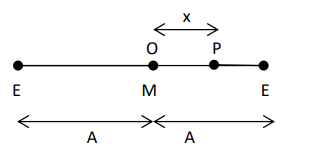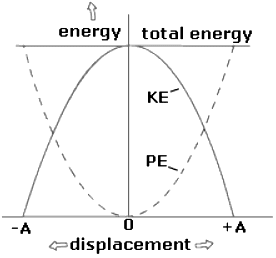Oscillations
Periodic Motion : A motion that repeats itself in equal intervals of time is called periodic motion. It is also called harmonic motion.
Examples. 1. Revolution of earth round the sun or about its own axis, 2. Revolution of moon and other artificial satellites around the earth, 3. Rotation of the electrons round the nucleus of an atom, 4. The motion of pendulum of a clock, 5. Motion of prongs of a tuning fork and 6. Oscillations of a loaded spring.
The two common periodic motions are the simple harmonic motion and uniform circular motion.
Oscillatory Motion : The motion of a particle is oscillatory if it moves back and forth or to and fro about the same path at equal intervals of time.
Examples. 1. Motion of a pendulum, 2. Motion of mass attached to a suspended spring, 3. Motion of atoms in a molecule or a lattice, 4. Motion of particles of the medium through which sound travels, 5. Up and down motion of a floating object on water when waves propagate through it, 6. Motion of prongs of a tuning fork.
All oscillatory motions are periodic in nature but all periodic motions are not oscillatory. For example, revolution of earth round the sun is periodic but not oscillatory and Rotation of the electrons round the nucleus of an atom is periodic but not oscillatory.
Some Definitions:
- The smallest time interval in which the motion repeats is called the Time Period (T). It is the time taken for one oscillation.
- The number of repetitions of motion that occur per second is called the frequency (f) of the periodic motion. Frequency is equal to the reciprocal of time period. .
- The maximum displacement of a particle from its mean position during an oscillation is called amplitude (A) of oscillation.
- Phase: It represents the state of motion of a particle in periodic motion. It is expressed in terms of fraction of period T or the fraction of angle measured from the instant when the body has crossed the mean position in the positive direction.
Simple Harmonic Motion (SHM)
Topic asked in Applied Physics 2023 (CBCS/NEP) question paper Section B - 3(a).
A particle is said to execute simple harmonic motion if the acceleration of the particle is directly proportional to the displacement of the particle from the mean position and it is directed towards the mean or equilibrium position. Ex. Oscillations of simple pendulum, oscillations of weight attached to spring.

Consider a particle executing oscillatory motion about the mean position (E - M - E) with E as the extreme position and M is the mean position) with amplitude A. Let be the displacement of the particle at an instant of time t. A restoring force F acts on the particle to bring it back to its mean position. This force is directly proportional to the displacement.
Mathematically,
or
This equation is called as Hooke's law and represents the Restoring force. Where is spring constant and its value is depends on stiffness of the spring.
The negative sign indicates that F acts opposite to the direction of motion of the particle.
The acceleration of an object moving with simple harmonic motion can be found by using Hooke's law in the equation for Newton's second law.
Comparing and
or
As
becomes :-
or
let where is called the angular velocity or angular frequency of oscillating particle.
Now, becomes :-
is called differential equation of SHM.
Solution of Differential equation of SHM
Displacement of the particle
The differential form of SHM is
or
Multiplying both the side of this equation by , we get
This equation can be expressed as:-
Integrating above equation we get:-
Here, C is the constant of integration.
When the displacement is maximum, i.e. x = a, the velocity of the particle
Putting this condition in equation 1 ,
Now equation - 1 becomes,
or
Equation - 2 is also the expression for the velocity of the particle executing SHM.
Rewriting equation - 2 as,
Integrating this equation,
gives,
where is the constant called the initial phase of the particle executing SHM. It is also called epoch.
or
The above equation is the solution of differential equation of SHM and is the expression for the displacement of the particle at time t.
Velocity of the particle executing SHM
If the initial position from where time is measured is the mean position, then
Thus . The velocity of the particle at a given instant of time t is given by differentiating the above equation, i.e.
As we know, , we have,
Thus the velocity of the particle is:-
Note: At the extreme position of oscillation, when , . At the mean position, , thus . Thus is maximum at mean position and zero at extreme position.
Acceleration of the particle executing SHM
The displacement of the particle is given by . If the particle starts from mean position when t = 0, then initial phase . Thus the above equation is
On Differentiating we get,
Differentiating again, we get
We know,
or the acceleration .
This gives the expression for the acceleration of the particle executing SHM.
Note: At the mean position, when , . Also at the extreme position , then i.e. a is maximum at the extreme position.
Time period of a particle executing SHM
The angular frequency of the particle executing SHM is given by where is the frequency. As , where is the time period of SHM, we get or ,
This equation can be written as:-
We know,
So Equation - 1 becomes,
As , and
Also we have assumed above
leading to
Energy of SHM

Consider a particle executing SHM represented by . The velocity of the particle is and its acceleration is .
The energy of the particle is the sum of its kinetic and potential energies. The particle having a displacement x is further moved through a small distance dx, then the work done:-
As , the work done is
or
Total work done in moving the particle from 0 to x is given by integrating the above equation,
or
This expression gives the potential energy of the particle.
The kinetic energy of the particle is .
As
Kinetic Energy becomes:-
The total energy of the particle is
So,
Average Values of Kinetic and Potential energy of SHM

Suppose a particle of mass executes SHM of period . The displacement of the particles at any instant t is given by, and velocity is given by,
Instantaneous Kinetic Energy is given by:-
if is time period, then
Average K.E. =
Instantaneous Potential Energy is given by:-
Average P.E. =
We know,
Average P.E. =
Thus, Total Energy =
Thus it is clear that the average kinetic energy of a SHM is equal to the average potential energy and is equal to half the total energy.
Total energy of the oscillating particle is the same at every point of oscillation

The expression for kinetic energy is
and potential energy expression is
The total energy at any point of oscillation is
-
At the extreme position, and thus from kinetic energy is zero (as the velocity is also zero). Thus . Also from As , at the extreme position, potential energy is
Total energy
-
At the mean position, kinetic energy is maximum as the velocity is maximum. Also as at mean position, from
and as , at the mean position, from .
Thus total energy
Thus from it is clear that total energy remains same at every point of oscillation.